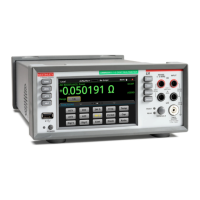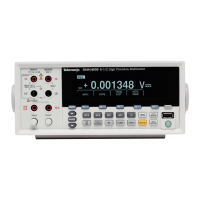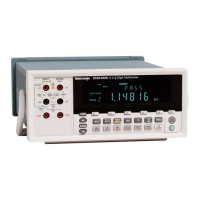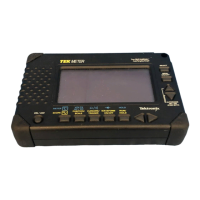8: Grading and binning resistors Model DMM7510 7½ Digit Multimeter
8-6 DMM7510-900-01 Rev. C / September 2019
Using TSP commands
The following TSP code is designed to be run from Keithley Instruments Test Script Builder (TSB).
TSB is a software tool that is available from tek.com/keithley
. You can install and use TSB to write
code and develop scripts for TSP-enabled instruments. Information about how to use TSB is in the
online help for TSB and in the “Introduction to TSP operation” section of the Model DMM7510
Reference Manual.
To use other programming environments, you may need to make changes to the example TSP code.
By default, the DMM7510 uses the SCPI command set. You must select the TSP command set
before sending TSP commands to the instrument.
To enable TSP commands:
1. Press the MENU key.
2. Under System, select Settings.
3. Set the Command Set to TSP.
4. At the prompt to reboot, select Yes.
This sequence of TSP commands grades resistors into established bins of accuracy. After the code
executes, the data is displayed in the Instrument Console of Test Script Builder.
Send the following commands for this example application:
-- Reset the instrument to default settings.
reset()
-- Create a user-defined reading buffer that can store up to 1 million readings.
bufferVar = buffer.make(1000000)
bufferVar.clear()
-- Set the measure function to 4-wire resistance.
dmm.measure.func = dmm.FUNC_4W_RESISTANCE
-- Set the number of power line cycles 1 PLC.
dmm.measure.nplc = 1
-- Immediately update autozero reference measurements and then disable the autozero
function.
dmm.measure.autozero.once()
-- Enable offset compensation for more accurate resistance reading.
dmm.measure.offsetcompensation.enable = dmm.ON
-- Configure digital I/O lines 1 through 4 as digital outputs. These I/O lines are used
to output binning code to component handler.
digio.line[1].mode = digio.MODE_DIGITAL_OUT
digio.line[2].mode = digio.MODE_DIGITAL_OUT
digio.line[3].mode = digio.MODE_DIGITAL_OUT
digio.line[4].mode = digio.MODE_DIGITAL_OUT
-- Clear digital I/O lines to 0.
digio.line[1].state = digio.STATE_LOW
digio.line[2].state = digio.STATE_LOW
digio.line[3].state = digio.STATE_LOW
digio.line[4].state = digio.STATE_LOW
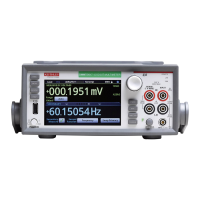
